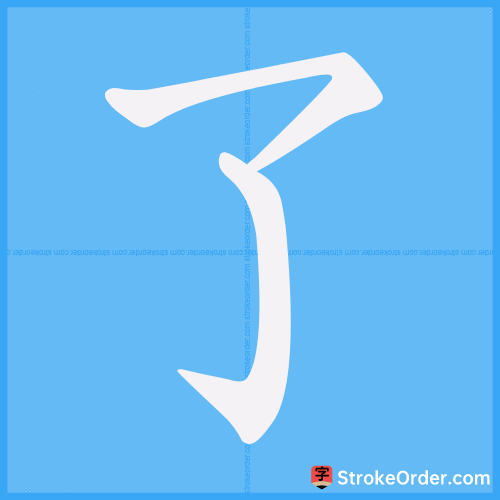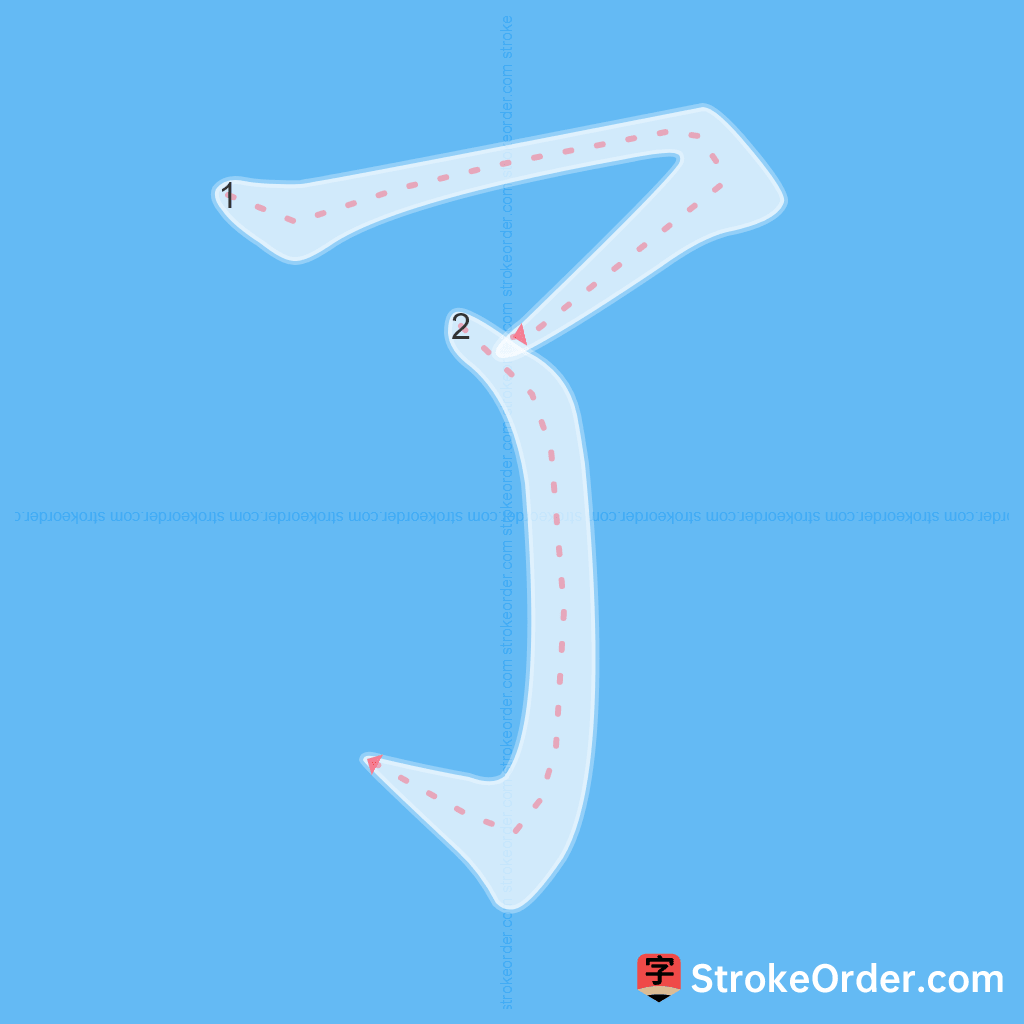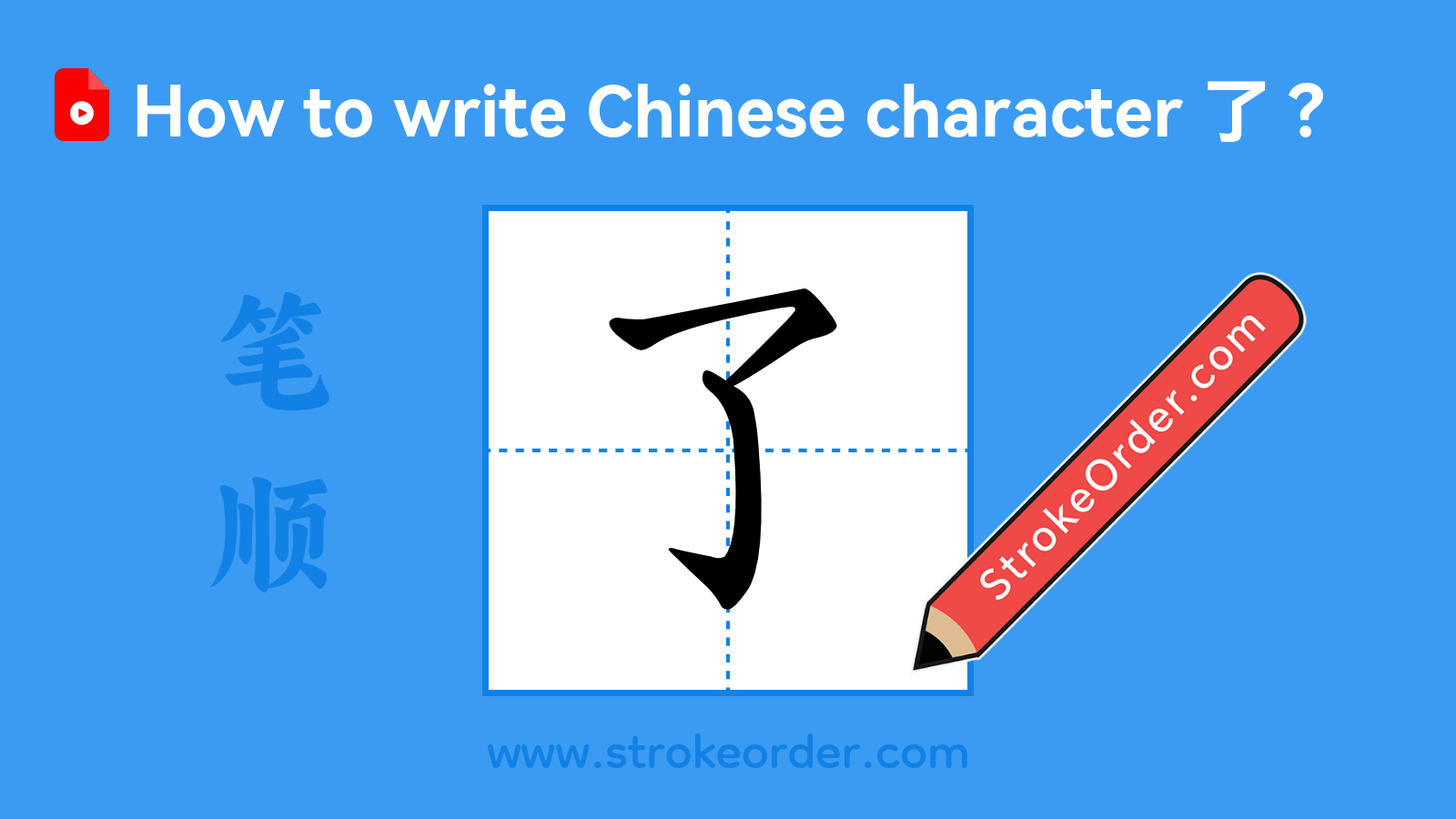了 Stroke Order
Animated Stroke Order of 了

Stroke Order Diagrams for 了

Step-by-Step Handwriting Guide for 了

Learn to Write Chinese Characters with Video Tutorials
Watch the video of writing the Chinese character "了", learn the correct stroke order (笔顺) of the character "了", and master the standard way of writing the character "了".

Free Printable Handwriting Practice with Stroke Order: 了
Printable Writing Practice Worksheet of "了" in Portrait Orientation (Tian Zi Ge)

Printable Writing Practice Worksheet of "了" in Landscape Orientation (Tian Zi Ge)

Information of 了
Pinyinle、 liǎo
Radical
乙
Strokes
2 strokes
Usage
★★★★★
Definition
(modal particle intensifying preceding clause) / (completed action marker), to know / to understand / to know, clear, look afar from a high place
了 [liǎo] 1. 明白,知道。 Understand, know. 2. 完结,结束。 End, conclude. 3. 在动词后,与“不”、“得”连用,表示可能或不可能。 Used after a verb with "not" or "can" to indicate possibility or impossibility. 4. 与“得”、“不得”前后连用,表示异乎寻常或情况严重。 Used with "can" or "cannot" to indicate something unusual or serious. Example: 明~。 一目~然。 Example: Clear understanding. Obvious at a glance. Example: 完~。 ~结。 Example: Completed. Concluded. Example: 看不~。 办得~。 Example: Cannot see. Can handle. Example: 那还~得! Example: That is serious! —— 了 [liǎo] 1. 手弯曲 ([En.] (of hand) bend) (of hand) bend. 2. 假借为“憭”、“悟”。懂得,明白其意思 ([En.] understand) Used for "understand". 3. 结束,了结 ([En.] end) Ended, concluded. —— 了 [liǎo] 1. 聪敏,颖慧 ([En.] wise) Wise, intelligent. 2. 清楚,明晰 ([En.] clear)。 Clear, distinct. 3. 明亮,光亮 ([En.] light) Bright, luminous. —— 了 [liǎo] 1. 完全,全然——与“无”、“不”连用,用在动词或形容词前面,表示范围,相当于“完全([En.] 没有)”、“完全([En.] 不)” ([En.] entirely)。 Completely, entirely—used before verbs or adjectives with "no" or "not" to indicate scope, equivalent to "completely (no)" or "completely (not)". 2. 放在动词之后,与“得”或“不”连用,表示可能 ([En.] used after a verb as a complement with “can” or “cannot” to indicate possibility or finality)。 Placed after a verb to indicate possibility when used with “can” or “cannot”. —— 了 [le] 助词,用在动词或形容词后,表示完成 Used after a verb or adjective to indicate completion. —— 了 [le] 1. 表示肯定语气 ([En.] indicates future certainty)。 Indicates affirmative tone. 2. 表示促进或劝止 ([En.] indicates the speeding up or stopping)。 Indicates promotion or discouragement. 3. 表示感叹语气 ([En.] indicates interj.)。 Indicates exclamatory tone. —— Example: 我已经问了老王。 Example: I have already asked Old Wang. Example: 明天又是星期六了。 Example: Tomorrow is Saturday again. Example: 快躲了! Example: Hurry and hide! Example: 好了! 别闹了! Example: Alright! Stop messing around!
come on
赔了夫人又折兵 péi le fū rén yòu zhé bīng
having given away a bride, to lose one's army on top of it (idiom) / to suffer a double loss after trying to trick the enemy
Can't help
cannot forget
complete enlightenment
direct and plainspoken (idiom); blunt / straightforward
Squeeze a sweat
吃不了兜着走 chī bu liǎo dōu zhe zǒu
lit. if you can't eat it all, you'll have to take it home (idiom) / fig. you'll have to take the consequences
to skimp / to work half-heartedly / not to bother
Dumbfounded
succinct and clear / brevity
远水解不了近渴 yuǎn shuǐ jiě bù liǎo jìn kě
Distant water cannot quench present thirst / Slowness can not meet hasty demand. / The aid is too slow in coming to be of any help.
not know much (about sth.) / do not quite understand / not be too clear (about sth.)
to understand / to realize / to find out
besides / apart from (... also...) / in addition to / except (for)
a modal particle indicating (that's all, only, nothing much)
let it be / let it pass / forget about it
extremely / exceedingly
Correct! / Oh, that's right, ... (when one suddenly remembers sth one wanted to mention) / Oh, by the way, ...
amazing / terrific / extraordinary
unavoidable / can't be avoided
unbearable / unable to endure / can't stand
desperately serious / disastrous / extremely / exceedingly
cannot do without / to be unavoidable / are bound to be many
to settle / to finish / to conclude / to wind up
exceptional / outstanding / dreadful / appalling
unfinished / outstanding (business) / unfulfilled
without end / incessantly / on and on
to have the final say / to be the one in charge
in the end
Input Method for 了
Pinyinle5
Wubi
bnh
Cangjie
nn
Zhengma
y
Four Corner
17207
Unicode
U+4e86
Same Pronunciation Characters
了僚嘹寥撩料疗瞭缭聊辽寮尥廖撂潦燎獠蓼钌鹩療繚膫蟟遼鐐鷯尞蹽嵺膋漻憀敹嶚嶛嫽璙暸窷竂賿蹘簝豂廫屪镽爎髎飉釕鄝憭爒尦炓䢧㡻㝋㺒㵳㙩㶫䄦䉼䑠䎆䍡䝀䜮䜍䨅䩍
Same Radical Characters
乙乞也习乡书买乱乾了予承乜乩乛乶㐌乧巜乸乪乷乴乤乥乫乬乭乮乯乲乺乻乼乽㐟㐢㐇㐝㐦㐓㐣㐗㐘㐐㐡㐞㐤㐈㐊㐋㐎㐏㐚㐔㐨㐖㐛㐍㐒㐧㐕㐠㐥㐑㐜㐙㐉
本文来自梦入芙蓉浦投稿,不代表汉字笔顺中文网英文版立场,如若转载,请注明出处:https://www.strokeorder.cn/strokeorder/16586.html

 微信扫一扫
微信扫一扫 